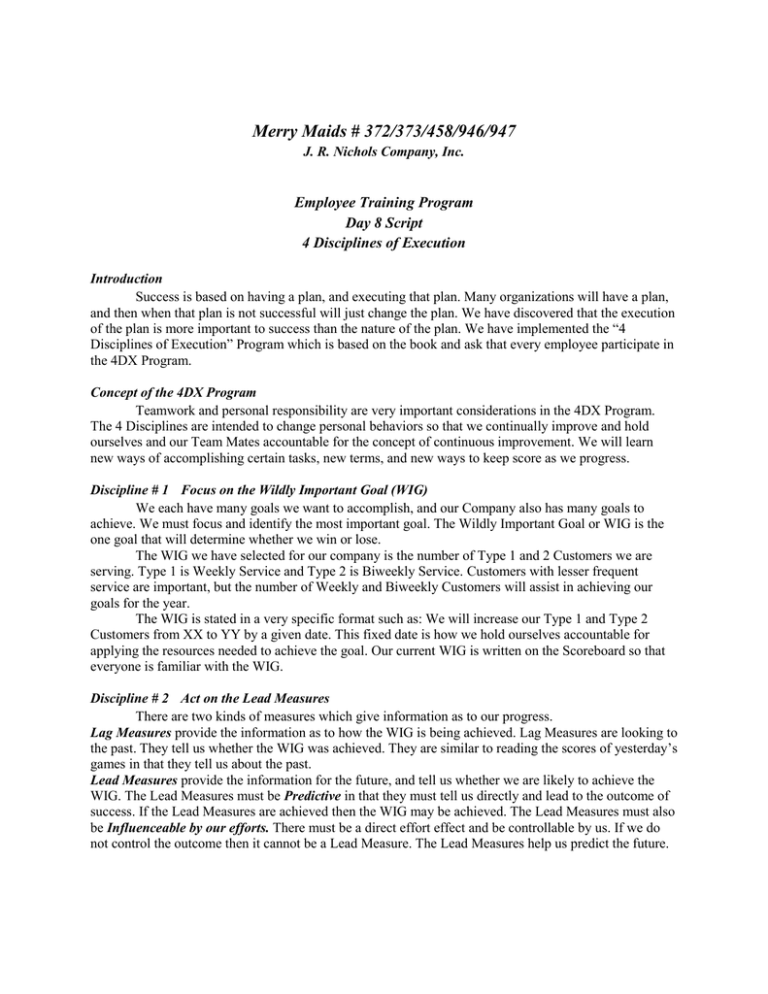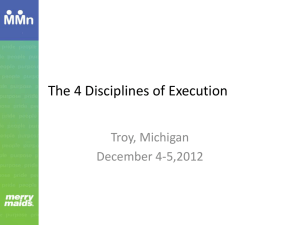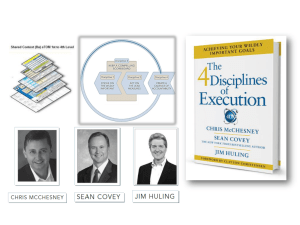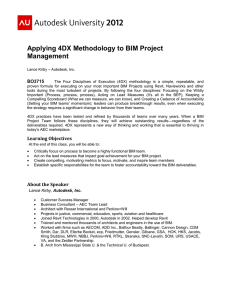DayEight4DXTraining
advertisement

Merry Maids # 372/373/458/946/947 J. R. Nichols Company, Inc. Employee Training Program Day 8 Script 4 Disciplines of Execution Introduction Success is based on having a plan, and executing that plan. Many organizations will have a plan, and then when that plan is not successful will just change the plan. We have discovered that the execution of the plan is more important to success than the nature of the plan. We have implemented the “4 Disciplines of Execution” Program which is based on the book and ask that every employee participate in the 4DX Program. Concept of the 4DX Program Teamwork and personal responsibility are very important considerations in the 4DX Program. The 4 Disciplines are intended to change personal behaviors so that we continually improve and hold ourselves and our Team Mates accountable for the concept of continuous improvement. We will learn new ways of accomplishing certain tasks, new terms, and new ways to keep score as we progress. Discipline # 1 Focus on the Wildly Important Goal (WIG) We each have many goals we want to accomplish, and our Company also has many goals to achieve. We must focus and identify the most important goal. The Wildly Important Goal or WIG is the one goal that will determine whether we win or lose. The WIG we have selected for our company is the number of Type 1 and 2 Customers we are serving. Type 1 is Weekly Service and Type 2 is Biweekly Service. Customers with lesser frequent service are important, but the number of Weekly and Biweekly Customers will assist in achieving our goals for the year. The WIG is stated in a very specific format such as: We will increase our Type 1 and Type 2 Customers from XX to YY by a given date. This fixed date is how we hold ourselves accountable for applying the resources needed to achieve the goal. Our current WIG is written on the Scoreboard so that everyone is familiar with the WIG. Discipline # 2 Act on the Lead Measures There are two kinds of measures which give information as to our progress. Lag Measures provide the information as to how the WIG is being achieved. Lag Measures are looking to the past. They tell us whether the WIG was achieved. They are similar to reading the scores of yesterday’s games in that they tell us about the past. Lead Measures provide the information for the future, and tell us whether we are likely to achieve the WIG. The Lead Measures must be Predictive in that they must tell us directly and lead to the outcome of success. If the Lead Measures are achieved then the WIG may be achieved. The Lead Measures must also be Influenceable by our efforts. There must be a direct effort effect and be controllable by us. If we do not control the outcome then it cannot be a Lead Measure. The Lead Measures help us predict the future. Discipline # 3 Keep a Compelling Scoreboard This is the discipline that encourages participation because it shows the score! Can you imagine a football game where there was no scoreboard? How soon would everyone lose interest? The scoreboard must be in a common area and clearly show the following characteristics: (1) The Goal we want to achieve, (2) The score we have currently achieved, (3) It must be easy to read, (4) It must readily indicate “Winning” or “Loosing”, (5) It must display Lead and Lag Measures. The artistry of the Scoreboard must appear to everyone and encourage them to participate. Discipline # 4 Create a Cadence of Accountability The final step in the 4DX Program is the most important as it determines the degree to which we will participate. Let’s define two important terms with this Discipline. Cadence is a frequently recurring cycle of accounting for past performance and planning for future actions. Cadence is the element that will keep us involved on a regular frequency. Accountability is making a personal commitment to the Team to move the score forward and following through in a disciplined way. We apply this concept to ourselves and to each member of the Team. We will hold ourselves accountable through a series of WIG Meetings. The rules for WIG Meetings are: (1) Conduct the meetings on the same day and same time each week, (2) Focus the agenda on the WIG, (3) Do not allow the Whirlwind, which is the business for the day, to interfere, (4) Report on Commitments by each person attending, (5) Review the Scoreboard and learn from successes and failures, (6) Clear the Path as necessary, and (7) Make new Commitments for the week. Review the 4DX The 4 Disciplines of Execution are: (1) Focus on the Wildly Important Goal (WIG), (2) Act on the Lead Measures, (3) Keep a Compelling Scoreboard, (4) Create a Cadence of Accountability.











